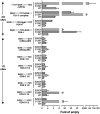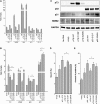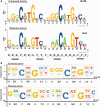Transactivation specificity is conserved among p53 family proteins and depends on a response element sequence code
- PMID: 23892287
- PMCID: PMC3794606
- DOI: 10.1093/nar/gkt657
Transactivation specificity is conserved among p53 family proteins and depends on a response element sequence code
Abstract
Structural and biochemical studies have demonstrated that p73, p63 and p53 recognize DNA with identical amino acids and similar binding affinity. Here, measuring transactivation activity for a large number of response elements (REs) in yeast and human cell lines, we show that p53 family proteins also have overlapping transactivation profiles. We identified mutations at conserved amino acids of loops L1 and L3 in the DNA-binding domain that tune the transactivation potential nearly equally in p73, p63 and p53. For example, the mutant S139F in p73 has higher transactivation potential towards selected REs, enhanced DNA-binding cooperativity in vitro and a flexible loop L1 as seen in the crystal structure of the protein-DNA complex. By studying, how variations in the RE sequence affect transactivation specificity, we discovered a RE-transactivation code that predicts enhanced transactivation; this correlation is stronger for promoters of genes associated with apoptosis.
Figures







Similar articles
-
Crystal structures of the DNA-binding domain tetramer of the p53 tumor suppressor family member p73 bound to different full-site response elements.J Biol Chem. 2013 Feb 15;288(7):4744-54. doi: 10.1074/jbc.M112.408039. Epub 2012 Dec 14. J Biol Chem. 2013. PMID: 23243311 Free PMC article.
-
The functional domains in p53 family proteins exhibit both common and distinct properties.Cell Death Differ. 2006 Jun;13(6):890-7. doi: 10.1038/sj.cdd.4401904. Cell Death Differ. 2006. PMID: 16543939 Review. No abstract available.
-
Structure of p73 DNA-binding domain tetramer modulates p73 transactivation.Proc Natl Acad Sci U S A. 2012 Apr 17;109(16):6066-71. doi: 10.1073/pnas.1115463109. Epub 2012 Apr 2. Proc Natl Acad Sci U S A. 2012. PMID: 22474346 Free PMC article.
-
The p73 DNA binding domain displays enhanced stability relative to its homologue, the tumor suppressor p53, and exhibits cooperative DNA binding.Biochemistry. 2008 Mar 11;47(10):3235-44. doi: 10.1021/bi7023207. Epub 2008 Feb 9. Biochemistry. 2008. PMID: 18260640
-
Therapeutic prospects for p73 and p63: rising from the shadow of p53.Drug Resist Updat. 2008 Aug-Oct;11(4-5):152-63. doi: 10.1016/j.drup.2008.08.001. Epub 2008 Sep 17. Drug Resist Updat. 2008. PMID: 18801697 Free PMC article. Review.
Cited by
-
Evolution of p53 transactivation specificity through the lens of a yeast-based functional assay.PLoS One. 2015 Feb 10;10(2):e0116177. doi: 10.1371/journal.pone.0116177. eCollection 2015. PLoS One. 2015. PMID: 25668429 Free PMC article.
-
Identification of new p53 target microRNAs by bioinformatics and functional analysis.BMC Cancer. 2013 Nov 21;13:552. doi: 10.1186/1471-2407-13-552. BMC Cancer. 2013. PMID: 24256616 Free PMC article.
-
Whole-genome cartography of p53 response elements ranked on transactivation potential.BMC Genomics. 2015 Jun 17;16(1):464. doi: 10.1186/s12864-015-1643-9. BMC Genomics. 2015. PMID: 26081755 Free PMC article.
-
Two p53 tetramers bind one consensus DNA response element.Nucleic Acids Res. 2016 Jul 27;44(13):6185-99. doi: 10.1093/nar/gkw215. Epub 2016 Mar 31. Nucleic Acids Res. 2016. PMID: 27034469 Free PMC article.
-
Quantitative Analysis of NF-κB Transactivation Specificity Using a Yeast-Based Functional Assay.PLoS One. 2015 Jul 6;10(7):e0130170. doi: 10.1371/journal.pone.0130170. eCollection 2015. PLoS One. 2015. PMID: 26147604 Free PMC article.
References
-
- Lane DP, Crawford LV. T antigen is bound to a host protein in SV40-transformed cells. Nature. 1979;278:261–263. - PubMed
-
- Kaghad M, Bonnet H, Yang A, Creancier L, Biscan JC, Valent A, Minty A, Chalon P, Lelias JM, Dumont X, et al. Monoallelically expressed gene related to p53 at 1p36, a region frequently deleted in neuroblastoma and other human cancers. Cell. 1997;90:809–819. - PubMed
-
- Yang A, Kaghad M, Wang Y, Gillett E, Fleming MD, Dotsch V, Andrews NC, Caput D, McKeon F. p63, a p53 homolog at 3q27-29, encodes multiple products with transactivating, death-inducing, and dominant-negative activities. Mol. Cell. 1998;2:305–316. - PubMed
-
- Collavin L, Lunardi A, Del Sal G. p53-family proteins and their regulators: hubs and spokes in tumor suppression. Cell Death Differ. 2010;17:901–911. - PubMed
Publication types
MeSH terms
Substances
Associated data
- Actions
Grants and funding
LinkOut - more resources
Full Text Sources
Other Literature Sources
Research Materials
Miscellaneous

